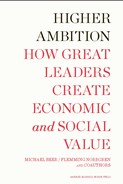Appendix
Research Design and Directions for Future Research
The findings in this study are based on interviews and discussions with thirty-six CEOs on three continents (see table I-1)—fifteen in the United States, two in Canada, fifteen in Europe, and four in India. In some cases, their participation included many conversations over a number of years, as well as contributing to several CEO round-table discussion forums that we have hosted; at a minimum, it consisted of a one- to two-hour face-to-face interview.
Sample Selection
Our sample of CEOs is purposive. Initially, we were seeking CEOs who would be thoughtful about the leadership challenges of creating lasting organizations that are high performing and that achieve high levels of commitment from their employees and other key stakeholders. We also wanted to ensure that they had a track record of success in meeting these dual objectives. Thus, at the start of our work, we sought CEOs who were creating both economic value and social capital. Over the course of our research, it became clear that the CEOs we were speaking with were concerned not only with creating social capital, but also with explicitly contributing to the social good. We therefore broadened the framing to our current formulation of leaders who are creating both economic value and social value.
To find these CEOs, we relied on recommendations from trusted colleagues, our own direct experience in working with some of these leaders, as well as the usual lists of most-admired companies and best places to work. As a check on these judgments, we applied two tests:
- The CEO’s company must have had a compounded annual growth rate in revenues, profits, and market capitalization that exceeded the fiftieth percentile of industry peers between 1997 and 2006, or for the CEO tenure. Corresponding figures were used for public or privately held organizations.
- There was evidence from the public record—articles, speeches, and views of those with direct knowledge—that the CEO was concerned with developing a people-centric, high-commitment culture.
CEOs who met these criteria received a letter from Professor Mike Beer on Harvard Business School stationery requesting their participation in a study of CEOs who are leading high-commitment, high-performance companies. We then interviewed those CEOs who chose to participate and continued to check for sufficient corroborating evidence to justify inclusion.
Directions for Further Research
By its nature, this study was intended as exploratory research to generate hypotheses about a distinctive model of leadership. It was not designed to test them rigorously, nor to “prove” that leaders who follow the practices described here will necessarily outperform their peers.
Our research sources were the CEOs themselves. While we exercised reasonable diligence to find corroborating external evidence that they were achieving results consistent with the theories they articulated, we do not know the extent of the gap between what these CEOs espouse and what is actually happening across the various parts of their companies. Indeed, we would suggest a fruitful area for further research would be in-depth, in-company research to explore the various aspects of this question: for example, how consistent are these companies in applying the approaches the CEO articulates? Just how different are the internal cultures and the nature of collaboration in these companies from others where CEOs are pursuing a more traditional leadership model? To what extent do these internal differences translate into genuine sources of advantage?
We also cannot be certain of the sustainability of the culture and performance of the companies in this study. Only a longitudinal study would allow us to answer this question. We know from past research and books—In Search of Excellence, Built to Last, and Good to Great, for example—that exceptional performance or practices do not always last. We expect the same thing will ultimately prove true of the companies in our study. While the leadership approaches described here can be no guarantee of survival, we would predict, however, that they will contribute to resilience, as we saw anecdotally in the case of Standard Chartered Bank’s weathering of the global financial crisis. We would therefore encourage further research into whether these leadership practices contribute positively to adaptation, resilience, and renewal, and if so, under what circumstances.
Finally, we do not claim to have provided a definitive articulation of the leadership model we are seeking to describe. We were struck by the consistency in how these CEOs spoke to us about the challenges of leading with a higher ambition and how they thought about the work of leadership itself, despite the widely varying contexts in which they were leading. The remarkable similarity in the principles and practices they described (and how different they were from those of other CEOs we have interviewed or worked with) convinced us that these leaders are converging on a common leadership paradigm. But we would welcome further research beyond the initial sketch we offer here to elaborate the principles and practices that constitute its essence.
